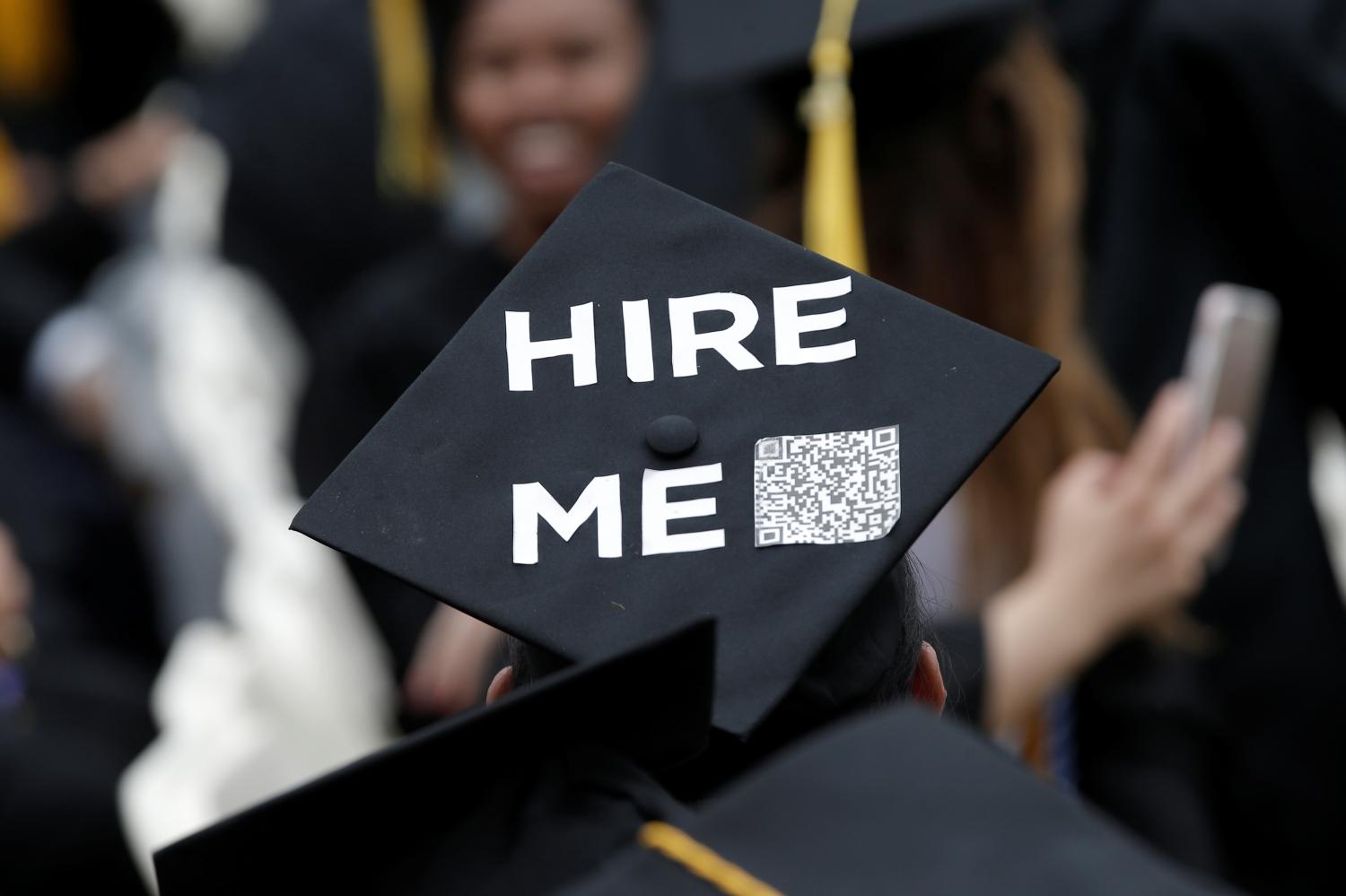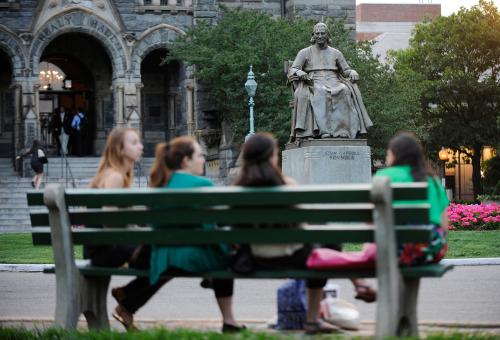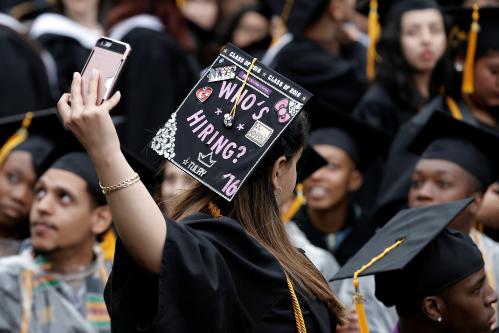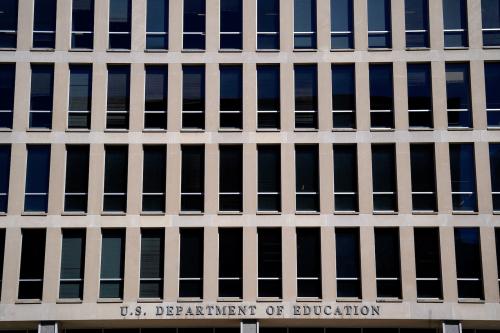Introduction
The Higher Education Act is overdue for reauthorization and risk-sharing is on the agenda.[1] Driven by a discontent with the system of accountability governing institutions of higher education, policymakers and experts on both sides of the aisle have proposed mechanisms that would have institutions pay a price when students face bad financial outcomes, like difficulty repaying their debt. This paper examines the issue of risk in higher education, introduces a market-based rationale for risk-sharing, and offers recommendations for implementing a risk-sharing regime.
College is risky business
For decades there has been a mission to get more and more young people to enroll in college. While the popular narrative about higher education in the United States includes discussion of rapid inflation and burdensome debt, there has been always been an implicit thread contending that college is worth it. And it’s no wonder why. Research has repeatedly concluded that going to college will generally allow an individual to accumulate more wealth over their lifetime than if they had not gone. For instance, a report from the Federal Reserve Bank of New York estimated that the financial return to an associate’s or a bachelor’s degree is about 15 percent.[2] Another commonly cited study, published by the Center on Education and the Workforce at Georgetown University, indicated that college graduates earn an average of one million dollars more than high school graduates over the course of their career.[3] We are quick to cite these estimates of large financial returns to college degrees as a rationale for encouraging more and more students to enroll in higher education, but we often neglect to discuss the variation in outcomes that these students will face. That college is, in fact, a risky proposition.
Some students will see the typical returns that are often discussed, others will win even bigger, but some will, unfortunately, be left worse off than if they hadn’t gone to college in the first place.
College is typically worth it. But that simple assertion fails to capture the fact that college, or any form of higher education, is a gamble. Some students will see the typical returns that are often discussed, others will win even bigger, but some will, unfortunately, be left worse off than if they hadn’t gone to college in the first place. This variation in outcomes can be explained by the decisions that students make about their education, but also by luck.
That same study that provided the oftcited figure of the one million dollar return to a bachelor’s degree also showed that the difference between lifetime earnings of the highest and lowest earning majors was 3.4 million dollars, more than three times the average earnings differential between college graduates and those with a high school diploma. Clearly, that million-dollar return is not a sure-thing.
And unlike program of study, many of the factors that determine the financial payoff of investments in higher education are unforeseeable. For example, most students enroll in higher education with the intention of completing their degree, but only about half of them will actually finish.[4] This means they will have paid the price of enrollment but won’t see the higher wages that come with having a degree. This group may often find themselves worse off financially than if they hadn’t enrolled in the first place.
Students face a number of other undesirable possibilities that will keep them from seeing big returns on their investments. These include the institution they’ve chosen turning out to be a dud; graduating during a recession (which can have lasting impact on earnings); and having the skills they acquired during college become obsolete due to innovation or policy change. Each of these possibilities are both out of the student’s control and have the potential to significantly impact their financial well-being.
Yes, college is worth it. But we also need to acknowledge the fact that it’s a gamble. And this gamble is especially problematic for students who finance their investments in education with debt, because they are often counting on the financial returns to their degree making the repayment of their debt affordable. With the price tag of higher education increasing at a rapid pace, today’s borrowers who find themselves underwater on their student debt are farther from financial well-being than borrowers of the past. Policy needs to take this reality into account.
Role of government in shielding students from risk
As we think about the role of the federal government in risk mitigation, it’s helpful to take a step back and remember why the government intervenes in student lending in the first place. In the absence of government intervention in student lending, educational opportunities that would pay large dividends, from both the collective and individual perspective, would go untaken because prospective students would be unable to get the cash they need to pay the upfront cost of enrollment. Unlike other types of consumer lending, student loans are not collateralized. This means that lenders have no recourse when borrowers default on their loans; the lender cannot repossess a borrower’s degree. In theory, borrowers could collateralize their student debt with their human capital under an agreement of indentured servitude. But that is obviously an untenable solution for many reasons, not the least of which is that indentured servitude is illegal.[5] In the absence of federal lending there would be insufficient liquidity to support a socially optimal level of investment in higher education. While the rationale for federal involvement in student lending is quite straightforward, it is rarely discussed; likely due to the fact that there is, as Milton Friedman once observed, a “reluctance to think of investment in human beings as strictly comparable to investment in physical assets.”[6]
Taking the federal involvement in student lending as given, we then must ask what the federal role should be in the mitigation of borrower risk. One way that the federal government can reduce risk for borrowers is to implement a system of institutional oversight that encourages general improvements in student outcomes. How to do that is beyond the scope of this report. Instead, the goal is to focus on the role of government in shielding borrowers from bad financial outcomes ex-post; after the damage has been done.
It’s helpful to realize that programs which compensate borrowers who face bad outcomes are essentially insurance policies, even if we aren’t used to thinking of them as such. Insurance is simply an agreement between two parties that one will provide compensation to the other in case of an adverse event. In the case of student lending, the adverse event is unaffordability of student loan repayment caused by lower than expected earnings. Compensation can come in the form of temporary relief from making payments or forgiveness. If we want borrowers to have insurance, there are two primary options for making that happen. First, borrowers could be encouraged (or required) to obtain loan insurance in the private market (as is done in mortgage lending).[7] Second, the government could provide insurance through the federal lending program. In theory either of these options would work. In practice, however, reliance on individuals to self-insure is impractical and introduces unnecessary complexity for borrowers who already struggle to understand higher education finance.[8] Not to mention, a robust market for insurance on student lending products does not yet exist. We also know that students tend to have overly optimistic expectations about their future earnings, which would make it difficult to effectively incent borrowers to use a voluntary insurance product.
The goals of a student loan repayment safety net
Given that government provision of loan repayment insurance is the preferred strategy, the next step is to determine the goals for risk mitigation and design policy to meet those goals. The first goal is for borrowers to never face unaffordable payments during intermittent periods of below normal earnings. We can think of this as the transitive aspect of insurance. It assists borrowers in smoothing consumption over time. Second, federal policy should ensure that borrowers who hold debts they are unlikely to ever be able to repay should not have to carry these debts indefinitely. Since student debt is not generally dischargeable in bankruptcy the federal aid system must incorporate forgiveness for permanently insolvent borrowers. However, if student loans were to become dischargeable in bankruptcy then the role of federal policy would be reduced to ensuring that borrowers payments fluctuated to accommodate transitive changes in earnings. Likewise, if the private market for student loan insurance products were to become more robust then we should reconsider the conclusion that the federal government should be the sole provider of insurance on student loans.
The implications of providing a safety net for borrowers
The crux of this discussion however, is that this intervention has serious implications for the higher education marketplace. In a free and competitive market, suppliers face a cost when their product fails to meet a buyer’s expectations. If the product is one that is purchased repeatedly, then the supplier will lose future sales from the disappointed buyer. In the case that the product is purchased infrequently, the seller will suffer a reputational cost that can drive down sales from other buyers. But if buyers are compensated by government intervention when a product fails to meet their expectations, these market forces are dampened. Buyers become more willing to make a purchase and at the same time there is a reduction in the incentive for suppliers to provide a product that meets the buyer’s expectation. The government intervention drives an increase in demand, which means that suppliers are able to sell more units of their product at a higher price. In essence, the spending on the consumer protection generates a pass through to suppliers.
Now, higher education is very far from a free and competitive marketplace for a number of reasons. But the players are not immune to the mechanisms described in the previous paragraph. This means that government provision of safety nets for borrowers has two troubling implications. First, these safety nets dampen the incentive for institutions to work toward having borrowers achieve good outcomes. Second, taxpayer spending on safety nets is being passed through, at least in part, to institutions of higher education. And those passthroughs are largest to the institutions whose students face the worst outcomes.
A rationale for risk-sharing
In discussions about risk-sharing, there is often a suggestion that it should function as a punitive mechanism. That is, institutions should pay a penalty when they fail to meet a particular objective. The problem with a system built on that premise is that it is likely to fall short of the goal unless two conditions are satisfied. First, there would need to be agreement on the objective. Since there is great diversity among stakeholders in higher education, finding common ground on a definition of success seems unlikely. For example, many object to using employment outcomes as an indication of institution quality because it neglects the non-pecuniary returns to education. Even a multidimensional objective, like an index of outcomes, would impose a particular set of values that would almost certainly generate disagreement. Second, that objective would need to be measurable and not susceptible to manipulation. For example, if it was determined that completion rates were the correct objective on which to base punishment then institutions might manipulate their success in meeting that objective by reducing standards for completion. These practical constraints mean that risk-sharing would have limited effectiveness as a punitive mechanism.
However, there is an alternative rationale for introducing risk-sharing into the system of accountability for institutions. Rather than serving to punish institutions, risk-sharing should be designed as a mechanism for correcting the distortion to the market that is created by the existence of a federally administered loan repayment safety net.
A risk-sharing regime
Loan safety nets create a distortion in the market because protecting borrowers from bad outcomes lets institutions off the hook. When institutions engage in practices that reduce the likelihood of student success, they don’t pay the price for the bad outcomes it generates themselves. Instead they impose that cost on taxpayers. For example, prior to the existence of repayment safety nets, institutions would need to worry about the reputational costs they would suffer if a large number of their former students were experiencing financial distress. However, the existence of safety nets mitigates the financial distress that borrowers might face and thus reduces the potential reputation costs for the institution. The key to fixing the distortion is to reassign the costs to the institutions that generate them.
In order to achieve an efficient reassignment of costs, institutions should be required to pay periodic premiums to the Department of Education for the provision of loan repayment insurance for borrowers. The premiums should be determined by estimating the cost that an institution’s former students have imposed on the system of loan repayment safety nets during the previous period. The frequency of payments should be set to minimize the administrative burden on institutions, but should be at least once per calendar year. Just like a driver would face higher car insurance premiums when they have a history frequently filing claims, institutions whose former students frequently make use of loan repayment safety nets would be on the hook to pay a higher premium.
The current regime of safety nets generates costs for taxpayers in a number of different ways. According to estimates based on fair-value accounting rules,[9] current student loan interest rates are not sufficient to cover the government’s cost of administering and financing the debt. This means that extending the repayment period with an income driven repayment plan will impose an additional expense on taxpayers, even if the longer repayment period results in borrowers paying more than they would have otherwise. Another, more obvious, source of expense is loan default and forgiveness. These expenses, as well as any other expenses associated with the administration of safety nets, should be tallied by institution in order to calculate the premiums to be charged to the institutions.
No additional data collection would be necessary to implement this regime, but additional resources would need to be devoted to support the Department of Education in generating institution-specific cost measures.
Implications of a risk-sharing regime
One of the most apparent implications of an experience-rated system of premiums is that institutions would have an incentive to reduce enrollment of students who have a lower statistical likelihood of success. Students who are likely to rely on safety nets during loan repayment would essentially become a liability to an institution. Students who need to rely on debt to finance their education would also likely see a reduction in the options available to them compared to students who pay without relying on debt. The less debt that a student takes on, the less that an institution is exposed to the potential of higher premiums caused by the student’s utilization of repayment safety nets. This would almost certainly reduce access among the most disadvantaged students.
Other risk-sharing proposals have recommended adjusting institutional outcomes to account for the different populations of students that they serve. The problem with that approach is that it hides subsidies to students in the financing mechanism when they would be more effective if delivered as grants. For example, suppose that we imposed the regime recommended above but gave institutions credits toward their balance for enrolling certain types of disadvantaged students. Now consider the alternative that those same resources were delivered directly to the disadvantaged student in the form of additional grants. These options impose the same cost on taxpayers, but the second goes farther because it ensures that the resources are utilized by the intended recipient. It also ensures that institutions make decisions regarding enrollment based on their perception of a student’s likelihood of success, which also helps students to avoid wasting resources on coursework that does not lead to a degree.
So in addition to imposing the premium based risk-sharing regime described above, the federal government should use at least part of the savings generated to conduct social policy through grant making. That is, additional grant dollars should be delivered to the set of students whom we wish to have greater access to higher education than the current system would create. This report will be agnostic about what social policy to carry out, but insists that social policy not be carried out through financing mechanisms.
Another implication of this regime is that students would likely face higher prices. When a tax is levied on a supplier, the incidence of the tax generally falls on both the supplier and the consumer. In this case, it means that the tax extracts some surplus away from institutions but also that institutions will increase tuition to cover the additional cost of doing business. And since price discrimination, the process of charging students different prices according to their ability to repay, is a widely used instrument in higher education, it is likely that price increases will be levied against the students who are least likely to succeed.
While this has implications that should be addressed, it is not necessarily the wrong outcome. Tuition will rise the most at institutions with a track-record of former students needing to rely on repayment safety nets. If students are sensitive to price in choosing where (or if) to enroll, then the result will be fewer students enrolling in institutions that have produced graduates (or stop-outs) who experienced difficulty paying back their debt. This is a socially desirable outcome.
It’s also worth noting that students, just like institutions, are the beneficiaries of loan repayment safety nets. So it is not necessarily inefficient for them to assist in covering the expense of those programs. Again, the goal of increasing access to college should be achieved through the provision of grant dollars rather through implicit subsidies in the financing mechanism, which can hide valuable price signals.
Unanswered concerns
This paper provides a theoretical rationale for a risk-sharing regime and provides a sketch of how to implement it in practice. Before a regime of this nature can be put in place, there are many additional complications to consider.
First, it is necessary to better understand the magnitude of the financial impact this regime would have on institutions. The Government Accountability Office (GAO) recently released a report indicating that federal student loan in income driven repayment will cost the Department of Education $74 billion.[10] Imposing that cost back on institutions (minus any tax revenue that offsets the cost to taxpayers) might have a crippling impact on the higher education industry, even taking into account the increased availability of subsidies in the form of grants. Before implementing this or any other risk-sharing regime, the GAO should perform an analysis to estimate the premiums that would be imposed on institutions today if we were to base them on past performance. The analysis should seek to understand the implications that these premiums would have on the operating capacity of these institutions, and attention should be paid to the distribution of impacts across institutions. If the premium structure proposed here is excessively disruptive, a modified version in which premiums are proportional (but not necessary equal) to the costs of providing safety nets would maintain many of the benefits of the proposed policy.
A second challenge worthy of additional consideration is that there is a lag between when institutions engage in activities that contribute to bad student outcomes and when they pay the price. For instance, suppose an institution allowed their instructional quality to decline such that their students had difficulty obtaining jobs after graduation. Problems with loan repayments might not occur for a number of years after the decline in instructional quality. Since the goal of the proposed risk-sharing regime is not to punish institutions for bad behavior, but rather to efficiently fund existing safety nets, this delay does not wholly undermine the intention of the policy. But it does create a problem in that institutions can close down to avoid having to pay their premiums. One approach to mitigate this problem would be to require institutions to pay estimated premiums that could be held in escrow until the actual premiums can be determined based on measurement of student outcomes. Consideration should be given to how this might impact on new institutions entering the market, since policy should aim to avoid creating barriers to innovation.
Conclusions
In this report I’ve discussed the issue of risk in higher education, introduced a market-based rationale for risk-sharing, and provided a sketch of how to implement a risk-sharing regime. The proposed regime does not seek to punish institutions who fail to meet an arbitrary standard, but instead seeks to eliminate the distortion of incentives that is created by the provision of loan repayment safety nets. And it simultaneously creates a more efficient system for financing those safety nets. If implemented in the form proposed here, the introduction of risk-sharing should be accompanied by a revision to the grant allocation formulas to ensure that college access for disadvantaged students is not undermined.
Acknowledgements
This report is part of a series of papers on higher education risk-sharing commissioned by the Center for American Progress with support from Bill & Melinda Gates Foundation and Lumina Foundation. The views expressed in this report are those of its authors and do not represent the views of the Center for American Progress, the foundations, their officers, or employees.
About the author
Beth Akers is a senior fellow at the Manhattan Institute. Prior to joining the Manhattan Institute she was a fellow in the Brookings Institution’s Center on Children and Families where she conducted much of the work for this paper. She did not receive financial support from any firm or person for this article or from any firm or person with a financial or political interest in this article. She is currently not an officer, director, or board member of any organization with an interest in this article.
[1] Senate Committee on Health, Education, Labor and Pensions (2015), “Risk-Sharing / Skin-in-the-Game Concepts and Proposals,” Retrieved from http://www.help.senate.gov/imo/media/Risk_Sharing.pdf
[2] Abel, J. R., & Deitz, R. (2014). Do the benefits of college still outweigh the costs?. Current Issues in Economics and Finance, 20(3). the Costs?” Federal Reserve Bank of New York, November 2014).
[3]Carnevale, A. P., Cheah, B., & Hanson, A. R. (2015). The economic value of college majors. Georgetown University Center on Education and the Workforce. Available at https://cew.georgetown.edu/cew-reports/valueofcollegemajors.
[4] Bowen, W. G., Chingos, M. M., & McPherson, M. S. (2009). Crossing the finish line: Completing college at America’s public universities. Princeton University Press.
[5] Dynarski, S. M. (2015). An Economist’s Perspective on Student Loans in the United States.
[6] A. Holt (2012), Milton Friedman – Student Aid Progressive?, Inside Higher Ed.
[7] C. Salerno (2016), What higher education needs is student loan insurance, Student Voices.
[8] Akers, E. J., & Chingos, M. M. (2014). Are College Students Borrowing Blindly?. Washington, DC: Brown Center on Education Policy, Brookings Institution, available at https://www.brookings.edu/research/reports/2014/12/10-borrowing-blindly-akers-chingos.
[9]Congressional Budget Office (2014), Fair-Value Estimates of the Cost of Selected Federal Credit Programs for 2015 to 2024, Retrieved from https://www.cbo.gov/sites/default/files/113th-congress-2013-2014/reports/45383-FairValue.pdf
[10] United States Government Accountability Office (2016), Education Needs to Improve Its Income-Driven Repayment Plan Budget Estimates. Retrieved from http://www.gao.gov/assets/690/681064.pdf
The Brookings Institution is committed to quality, independence, and impact.
We are supported by a diverse array of funders. In line with our values and policies, each Brookings publication represents the sole views of its author(s).










